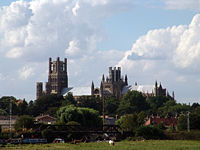William Longchamp Cleric
William Longchamp (died 1197), sometimes known as William de Longchamp or William de Longchamps, was a medieval Lord Chancellor, Chief Justiciar, and Bishop of Ely in England. Born to a humble family in Normandy, he owed his advancement to royal favour. Although contemporary writers accused Longchamp's father of being the son of a peasant, he held land as a knight. Longchamp first served an illegitimate son of King Henry II, but quickly transferred to the service of Richard I, Henry's eldest surviving son. When Richard became King in 1189, Longchamp paid £3,000 for the office of Chancellor, and was soon named to the see, or bishopric, of Ely and appointed legate by the pope. Longchamp governed England while Richard was on the Third Crusade, but his authority was challenged by Richard's brother, John, who eventually succeeded in driving Longchamp from power and from England. Longchamp's relations with the other leading English nobles were also strained, which contributed to the demands for his exile. Soon after Longchamp's departure from England, Richard was captured on his journey back to England from the crusade and held for ransom by Henry VI, Holy Roman Emperor. Longchamp travelled to Germany to help negotiate Richard's release. Although Longchamp regained the office of Chancellor after Richard's return to England, he lost much of his former power. He aroused a great deal of hostility among his contemporaries during his career, but he retained Richard's trust and was employed by the king until the bishop's death in 1197. Longchamp wrote a treatise on the law, which remained well known throughout the later Middle Ages.
Search
Christian bishop
| From | 1190 |
|---|---|
| To | 1197 |
